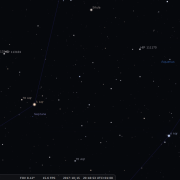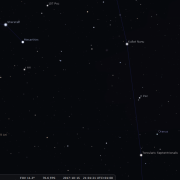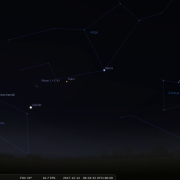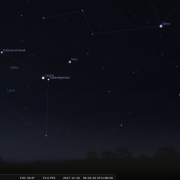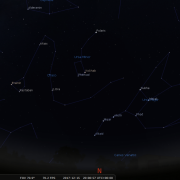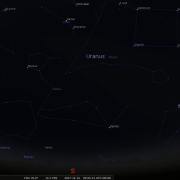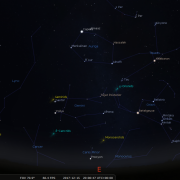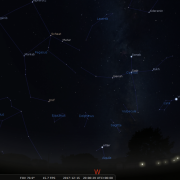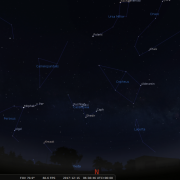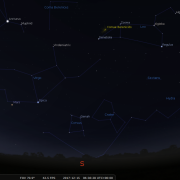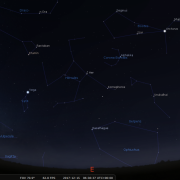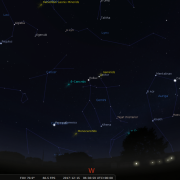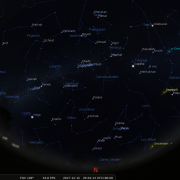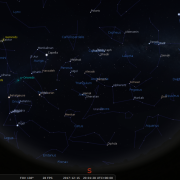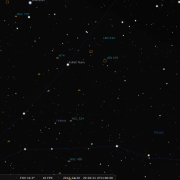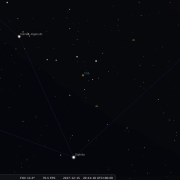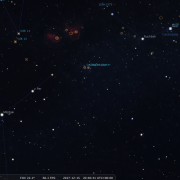✭✭✭ Seasons Greetings to All our Members ✭✭✭
Welcome to the WDAS monthly newsletter for December 2017: a digest of the month's latest contributions to our website. Below you'll find Society News, Sky Notes and In-Focus articles printed in full. There's also future events, and trailers for other articles which appear in full on the website - just a click away!
Society News

We have now booked the Hare and Hounds for Dec 15th (Friday). The booking is initially for a dozen at 19:30h.
If you would like to come along (the food is excellent and the evening most enjoyable) we shall continue taking names, rank and serial numbers at the December society meeting on the 5th, failing that please contact Mark Dawson. First come, first serve.
Taxi arrangements will be discussed at the meeting.
Christmas Menu
At the Hare and Hounds, Hawsker, Whitby YO22 4LH. Tel 01947 880453. Price:£24.95.
Starters
- Lightly Spiced Roast Carrot And Red Lentil Soup
- Pigeon Breast On A Bacon & Thyme Mashed Potato with Juniper Berry Jus
- Atlantic Prawn, Crayfish & Smoked Salmon Cocktail with Marie Rose Sauce
- Oat Coated Brie with Apple & Cinnamon Relish
- Chicken & Ham Hock Terrine with An Apricot Jelly
All the above served with crusty bread
Main Course
- The Hounds Own Turkey Ballantine, Stuffed with Sausage Meat, Wrapped In Streaky Bacon, Served with Creamed Potatoes, Cranberry Jelly &Roast Root Vegetables
- Chunk Of Cod On A Bed Of Roasted Garlic & Parsley Creamed Potatoes With A Dill & Caper Butter
- Wild Mushroom, Blue Cheese and Spinach Tartlet, With Poached Hen Egg & Pesto Drizzle
- Pork Loin Rolled In Parma Ham, Served On A Bed Of Smoked Pancetta & Parmesan Risotto
- The Hounds Game Pie - Tender Game Encased In A Short Crust Pastry, Served With Creamed Potatoes & Seasonal Vegetables
- Slow Roasted Shin Of Beef, Parsnip Puree, Creamed Potatoes and Shallot and Port Gravy
Desserts
- Traditional Christmas Pudding with Rum Custard
- Chocolate Parfait With Chestnut Shortbread
- Winterberry Cheesecake With Vanilla Ice-cream
- Cheese Platter, With Selection Of Biscuits & Spiced Fig Chutney
- Ginger Bread & Cinnamon Creme Brûlée With Homemade Sultana & Oat Cookie
Sky Notes
In this month's Sky Notes:
Planetary Skylights
Evening
 Planetary wise it is an unusual ending to the year, with no bright planets visible in the evening sky. There are planets to be tracked down, but at magnitude +5.65 Uranus will require a pair of binoculars, and Neptune (mag +7.8) will in reality need a telescope to verify it.
Planetary wise it is an unusual ending to the year, with no bright planets visible in the evening sky. There are planets to be tracked down, but at magnitude +5.65 Uranus will require a pair of binoculars, and Neptune (mag +7.8) will in reality need a telescope to verify it.
Uranus resides in the ESE toward the bottom of the ‘V’ asterism in Pisces, not far above the star Torcularis Septentrionalis. Perhaps the easiest way to locate it is by using Sheratan and Mesarthim in Aries (the crooked leg of the ram) and sighting down five times the distance between them, and then up one. ‘Herschel’s planet’ will yield a very small grey/green disk in a telescope. The moon passes just below the bottom of the ‘V’ on the 27th.
 Neptune is located to the SSE in the constellation of Aquarius, and you will require a telescope to identify it. It resides below the asterism known as the ‘water jar’ not far beneath Lamda Aquarii. Through a telescope Neptune resembles a tiny blue/grey disk. The moon lies below/left on the 24th.
Neptune is located to the SSE in the constellation of Aquarius, and you will require a telescope to identify it. It resides below the asterism known as the ‘water jar’ not far beneath Lamda Aquarii. Through a telescope Neptune resembles a tiny blue/grey disk. The moon lies below/left on the 24th.
Morning

 Conspicuous planetary action is confined to the dawn sky, where Jupiter and Mars can be spotted. Mars lies upper right of brighter Jupiter as the month commences, but seemingly drops downwards and toward Jupiter as we head into the New Year, when a spectacular conjunction occurs on the 6th. The moon lies above and between on Dec 14th.
Conspicuous planetary action is confined to the dawn sky, where Jupiter and Mars can be spotted. Mars lies upper right of brighter Jupiter as the month commences, but seemingly drops downwards and toward Jupiter as we head into the New Year, when a spectacular conjunction occurs on the 6th. The moon lies above and between on Dec 14th.
 Finally, Mercury pops up smack above the SE horizon later in December. Look for the elusive planet from the 22nd onwards viewing around 07:15h. You will require a clear, unobstructed horizon and are looking for a reasonably bright ‘star’ approximately 4 degrees above it. Use binoculars if you cannot initially spot Mercury with just the naked eye.
Finally, Mercury pops up smack above the SE horizon later in December. Look for the elusive planet from the 22nd onwards viewing around 07:15h. You will require a clear, unobstructed horizon and are looking for a reasonably bright ‘star’ approximately 4 degrees above it. Use binoculars if you cannot initially spot Mercury with just the naked eye.
Meteors & Comets

Meteor activity reaches a peak at this time of year and given any clear skies the chance of spotting some shooting stars increases markedly. Considered to be the most prolific meteor shower of the year, the Geminids are active from December 7-16, reaching a peak on December 13/14th.
Geminids originate from debris shed by a small ‘object’ called Phaethon, an asteroid which may be the nucleus of a ‘dead’ comet. Phaethon passes within 10 million miles of the Sun causing the object to deposit material over great swathes of the inner solar system. It is the denser strands of this debris that Earth now encounters each year. In fact Geminids were not recorded before the 1860’s, and it is only during the latter part of the 20th century that Geminid activity has increased to the levels now witnessed, ie upwards of 120 per hour, although by the end of the 21st century rates will decrease again.
Typical Geminid’s are about the size of a large coffee granule and penetrate deep into Earth’s atmosphere at 22 miles per second, before ‘burning up’ - (two processes; known as ablation and ionisation) Generally Geminids produce fewer persistent trains than some showers, however bright examples (1st mag and below) quite often leave luminous trails, sometimes blue/ white, green, yellow or even orange in hue. These correspond to specific elements present in the meteoroid as well as the effect of interactions with air molecules due to velocity
The shower radiant lies close to Castor, visible in the east by 21:00h. Under ideal conditions the Zenith Hourly Rate (ZHR) can reach well over one hundred meteors, however actual observed rates by any one person are always substantially lower. If skies are clear, the late evening of the 13th will yield quite a few Geminids, but with the moon near new, the early morning hours of the 14th will afford the highest rates.
If clear, conditions should also be favourable for the much less prolific Ursid meteor shower. The shower is active from Dec 17-25th, peaking on Dec 22/23rd. Hourly rates of 8-12 are normal, however occasionally, and erratically, Ursids produce strong outbursts, so it is a case of watching the skies. The radiant lies close to the Great Bear- up in the NE.
November 2017 Sky Charts
|
Looking North
Mid-Decvember - 20:00h |
Looking South |
|
Looking East
Mid-December - 20:00h |
Looking West
Mid-December - 20:00h |
| Looking North (morning) Mid-December - 06:30h |
Looking South (morning) Mid-December - 06:30h |
| Looking East (morning) Mid-December - 06:30h |
Looking West (morning) Mid-December - 06:30h |
| Northern Aspect Mid-December - 20:00h |
Southern Aspect Mid-December - 20:00h |
Additional Image Credits:
- Planets and Comets where not otherwise mentioned: NASA
- Sky Charts: Stellarium Software
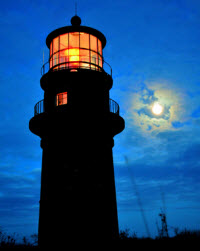 The Sun reaches its lowest position in the sky on December 21st this year; the date of the winter solstice and officially the start of winter in the northern hemisphere. From our latitude the Sun arcs little more than 12 degrees above Southern horizon at local noon, standing before the stars of Sagittarius. Useful daylight amounts to just 7½ hrs - ’the shortest day’.
The Sun reaches its lowest position in the sky on December 21st this year; the date of the winter solstice and officially the start of winter in the northern hemisphere. From our latitude the Sun arcs little more than 12 degrees above Southern horizon at local noon, standing before the stars of Sagittarius. Useful daylight amounts to just 7½ hrs - ’the shortest day’.
Latest sunrise and earliest sunset do not however occur on the winter solstice date. The Sun sets earliest mid-month (15 or 16th) and rises latest near the end of December (27 or 28th). The fact that within a month evenings will start to grow lighter again should be cause for some kind of celebration,
Starting this month is a new feature in which we take a brief look at various celestial objects of particular interest for one reason or another. These are a star, a galaxy, a nebula and a cluster. To keep matters simple all the objects are located on or close to the meridian line, due south, around mid month at 20:00h ( GMT time). The objects are ranked as Easy, Medium or a Challenge to observe with the type of optical aid required to spot them.
Star
Eye/Binoculars, Easy/Medium
Omicron Ceti – proper name Mira, known to early astronomers as Mira the Wonderful. Mira is a red giant pulsating variable star that lies approximately 320 light-years away in the constellation Cetus the Whale. Each ‘pulse’ lasts a decade or more, with 10,000 year intervals between each pulse, Mira increasing in luminosity after each pulse. The pulsations of Mira variables (some 7000 are known) cause the star to expand and contract and change its temperature. In Mira, the highest luminosity occurs close to the time when the star is hottest and smallest.
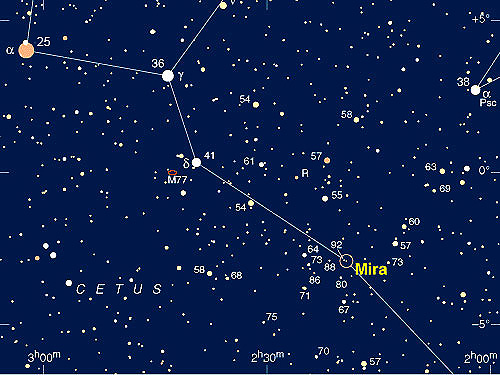
Locating Mira in the Sky (Image Credit: Unknown)
The shorter time scale variability of Mira occur on a regular schedule of about 11 months, typically taking it from mag +3.5, in which case it will easily be seen with the naked eye, right out to mag 10, almost beyond the limit of typical binoculars. Historically Mira has even been recorded at mag +2. Mira’s last brightness peak was in late January 2017 with the next peak scheduled for December 29th 2017. Roughly speaking, Mira reaches its peak a month earlier each year. In 2007 it was discovered that Mira was leaving a trail of hot gas in its wake, resembling a comet- like tail in ultraviolet images and stretching for over 13 light years. Mira has a white dwarf companion star, Mira B, which is accreting some of this material in the form of a proto planetary disk.

Mira appears as a small white dot in the bulb-shaped structure at right, and is moving from left to
right in this view. The shed material can be seen in light blue. The dots in the picture are stars and
distant galaxies. The large blue dot at left is a star that is closer to us than Mira. (NASA/JPL-Caltech)
Galaxy
Medium, Telescope
Messier 74 (also known as NGC 628) is a spiral galaxy in the constellation Pisces. M74 is the brightest member of the M74 Group, a group of 5–7 galaxies that lie approximately 31 – 33 million light-years away from Earth. The galaxy contains two clearly defined spiral arms viewed face on and is used as an archetypal example of a grand design spiral galaxy. The galaxy's low surface brightness makes it quite difficult for astronomers to observe in light polluted skies and it is best viewed under low magnification. It is estimated that M74 is home to about 100 billion stars.
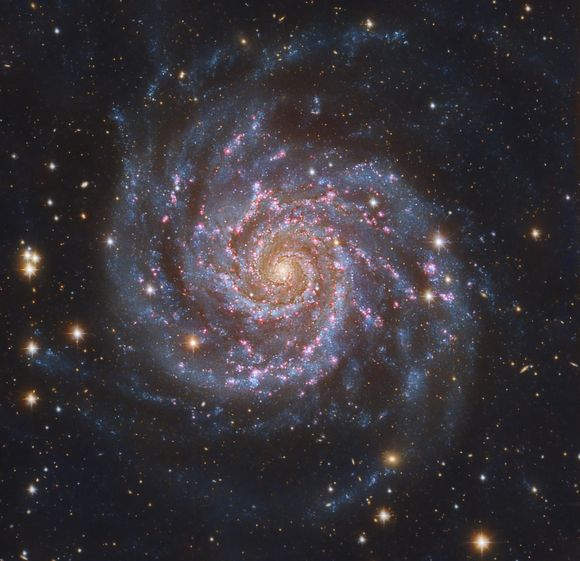
Messier 74/NGC 628: M74 Galaxy (Credit: NASA)
Nebula
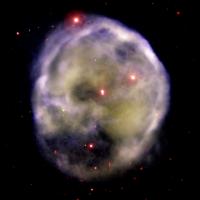
NGC 246 Nebula in Cetus (NASA)
Challenge, Telescope
NGC 246 (C56) Known as the Skull nebula, this interesting planetary nebula discovered by William Herschel in 1785 lies in Cetus, at a distance of 1600 light years and is some 2-3 light years in diameter. You can locate it approximately 6° north-northeast of the 2nd-magnitude star Beta Ceti and about 1.5° south-southeast of 4.8-magnitude Phi1 Ceti.
The complex braided structure of NGC 246’s outer ring, is caused by high-velocity gases pushing outward from the hot (~200,000 K) central star. At mag 10.7 you will require a telescope to spot it, but it is worth it.
Cluster
Easy, Binocular/Telescope
NGC 869 & 884 – the double cluster in Perseus, (often designated h Persei and χ Persei, respectively). At this time of year this stunning object is located near the zenith on the meridian and lies roughly midway between Perseus and Cassiopeia in the sky. The clusters are very young, it's estimated that NGC 869 is 5.6 million years old and NGC 884 only 3.2 million years old. They lie approximately 7500 light years distant and are thought to be separated by around 500 light years. The clusters are approaching us at 24 miles per second. Estimates vary as to how many stars are contained within the clusters, but between them they contain over 400 hot blue-white super massive and super luminous giant stars. Known from antiquity, the clusters can be seen with the naked eye and binoculars, but at low magnification through a scope they really are exquisite, one of the best objects for a smaller instrument.
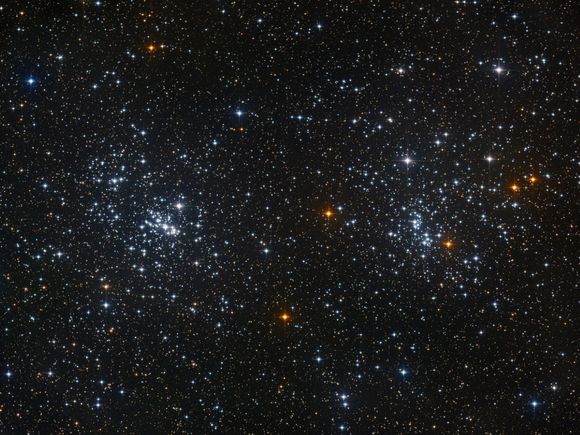
NGC 869 & 884: Double Cluster in Perseus (Credit: NASA)

